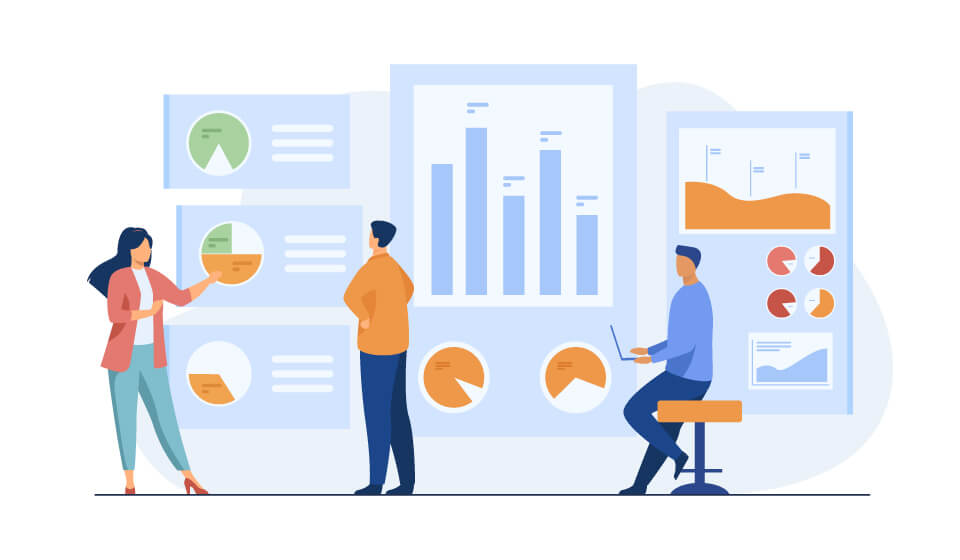Crafting meaningful narratives from data is a critical skill for all types of decision making—in business, and in our public discourse
As companies connect decision-makers with advanced analytics at all levels of their organizations, they need both professional and citizen data scientists who can extract value from that data and share. These experts help develop process-driven data workflows, ensuring employees can make predictive decisions and get the greatest possible value from their analytics technologies.
But understanding data and communicating its value to others are two different skill sets. Your team members’ ability to do the latter impacts the true value you get from your analytics investment. This can work for or against your long-term decision-making and will shape future business success.
There are well-established connections between stories and their ability to guide people’s decisions, even in professional settings. Sharing data in a way that adds value to decision-making processes still requires a human touch. This is true even when that data comes in the form of insights from advanced analytics.
That’s why data storytelling is such a necessary activity. Storytellers convert complex datasets into full and meaningful narratives, rich with visualizations that help guide all types of business decisions. This can happen at all levels of the organization with the right tools, skill sets, and workflows in place. This article highlights the importance of data storytelling in enterprise organizations and illustrates the value of the narrative in decision-making processes.
What Is Data Storytelling?
Data storytelling is an acquired skill. Employees who have mastered it can make sense out of a body of data and analytics insights, then convey their wisdom via narratives that make sense to other team members. This wisdom helps guide decision-making in an honest, accurate, and valuable way.
As we described previously, reporting that provides deep, data-driven context beyond the static data views and visualizations is a structured part of a successful analytic lifecycle. Three structural elements of data storytelling contribute to its success:
- Data: Data represents the raw material of any narrative. Storytellers must connect the dots using insights from data to create a meaningful, compelling story for decision-makers.
- Visualization: Visualization is a way to accurately share data in the context of a narrative. Charts, graphs, and other tools “can enlighten the audience to insights that they wouldn’t see without [them],” Forbes observes, where insights might otherwise remain hidden to the untrained eye.
- Narrative: A narrative enables the audience to understand the business and emotional importance of the storyteller’s findings. A compelling narrative helps boost decision-making and instills confidence in decision-makers.
In the best cases, storytellers can craft and automate engaging, dynamic narrative reports using the very same platform they use to prepare data models and conduct advanced analytics inquiries. Processes may be automated so that storytellers can prepare data models and conduct inquiries easily as they shape their narratives. But whether the storyteller has access to a legacy or modern business intelligence (BI) platform, it’s the storyteller and his or her capabilities that matter most.
Who Are Your Storytellers?
“The ability to take data—to be able to understand it, to process it, to extract value from it, to visualize it, to communicate it—that’s going to be a hugely important skill in the next decades.”
— Hal R. Varian, Chief Economist, Google, 2009
The history of analytics has been shaped by technical experts, where companies prioritized data scientists who can identify and understand raw information and process insights themselves. But as businesses became more data-driven, the need for insights spread across organizations. Business success called for more nuanced approaches to analysis and required broader access to analytics capabilities.
Now, organizations more often lack the storytelling skill set—the ability to bridge the gap between analytics and business value. Successful storytellers embody this “bridge” as a result of their ability to close the gap between analytics and business decision-makers at all levels of the organization.
Today, a person doesn’t need to be a professional data scientist to master data storytelling. “Citizen data scientists” can master data storytelling in the context of their or their team’s decision-making roles. In fact, the best storytellers have functional roles that equip them with the right vocabulary to communicate with their peers. It’s this “last mile” skill that makes the difference between information and results.
Fortunately, leading BI platforms provide more self-service capabilities than ever, enabling even nontechnical users to access in-depth insights appropriate to their roles and skill levels. More than ever, employees across business functions can explore analytics data and hone their abilities in communicating its value to others. The question is whether or not you have an organization that can facilitate their development.
Three Common Mistakes in Data Storytelling
Of course, there are both opportunities and risks when using narratives and emotions to guide decision-making. Using a narrative to communicate important data and its context means listeners are one-step removed from the insights analytics provide.
These risks became realities in the public discourse surrounding the 2020 global COVID-19 pandemic. Even as scientists recommended isolation and social distancing to “flatten the curve”—slow the spread of infection—fears of an economic recession grew rampant. Public figures often overlooked inconvenient medical data in favor of narratives that might reactivate economic activity, putting lives at risk.
Fortunately, some simple insights into human behavior can help prevent large-scale mistakes. Here are three common ways storytellers make mistakes when they employ a narrative, along with a simple use case to illustrate each example:
- “Objective” Thinking: In this case, the storyteller focuses on an organizational objective instead of the real story behind the data. This might also be called cognitive bias. It’s characterized by the storyteller approaching data with an existing assumption rather than a question. The analyst therefore runs the risk of picking data that appears to validate that assumption and overlooking data that does not.Imagine a retailer who wants to beat its competitor’s customer service record. Business leaders task their customer experience professionals with proving this is the case. Resolute on meeting expectations, those analysts might omit certain data that doesn’t tip the results in favor of the desired outcome.
- “Presentative” Thinking: In this case, the storyteller focuses on the means by which he or she presents the findings—such as a data visualization method—at risk of misleading, omitting, or watering down the data. The storyteller may favor a visualization that is appealing to his or her audience at the expense of communicating real value and insights.Consider an example from manufacturing. Imagine a storyteller preparing a narrative about productivity for an audience that prefers quantitative data visualization. That storyteller might show, accurately, that production and sales have increased but omit qualitative data analysis featuring important customer feedback.
- “Narrative” Thinking: In this case, the storyteller creates a narrative for the narrative’s sake, even when it does not align well with the data. This often occurs when internal attitudes have codified a specific narrative about, say, customer satisfaction or performance.During the early days of testing for COVID-19, the ratio of critical cases to mild ones appeared high because not everyone infected had been tested. Despite the lack of data, this quickly solidified a specific media narrative about the lethality of the disease.
Business leaders must therefore focus on maximizing their “insight-to-value conversion rate,” as Forbes describes it, where data storytelling is both compelling enough to generate action and valuable enough for that action to yield positive business results. Much of this depends on business leaders providing storytellers with the right tools, but it also requires encouragement that sharing genuine and actionable insights is their top priority.
Ensuring Storytelling Success
“Numbers have an important story to tell. They rely on you to give them a clear and convincing voice.”
— Stephen Few, Founder & Principal, Perceptual Edge®
So how can your practical data scientists succeed in their mission: driving positive decision-making with narratives that accurately reflect the story behind the data your analytics provide? Here are some key tips to relay to your experts:
- Involve stakeholders in the narrative’s creation. Storytellers must not operate in a vacuum. Ensure stakeholders understand and value the narrative before its official delivery.
- Ensure the narrative ties directly to analytics data. Remember, listeners are a step removed from the insights your storytellers access. Ensure all their observations and visualizations have their foundations in the data.
- Provide deep context with dynamic visualizations and content. Visualizations are building blocks for your narrative. With a firm foundation in your data, each visualization should contribute honestly and purposefully to the narrative itself.
- Deliver contextualized insights. “Know your audience” is a key tenant in professional writing, and it’s equally valuable here. Ensure your storytellers understand how listeners will interpret certain insights and findings and be ready to clarify for those who might not understand.
- Guide team members to better decisions. Ensure your storytellers understand their core objective—to contribute honestly and purposefully to better decision-making among their audience members.
As citizen data science becomes more common, storytellers and their audience of decision-makers are often already on the same team. That’s why self-service capabilities, contextual dashboards, and access to optimized insights have never been so critical to empowering all levels of the organization.
Getting Started: Creating a Culture of Successful Storytelling
Insights are only valuable when shared—and they’re only as good as your team’s ability to drive decisions with them in a positive way. It’s data storytellers who bridge the gap from pure analytics insights to the cognitive and emotional capacities that regularly guide decision-making among stakeholders. As you might have gleaned from our two COVID-19 scenarios, outcomes are better when real data, accurate storytelling, and our collective capacities are aligned.
But storytellers still need access to the right tools and contextual elements to bridge that gap successfully. Increasing business users’ access to powerful analytics tools is your first step toward data storytelling success. That means providing your teams with an analytics platform that adds meaning and value to business decisions, no matter their level in your organization.
Pyramid Analytics differentiates itself from other enterprise BI platforms with its built-in data governance, allowing leaders to track the lineage of data sets and ensure their accuracy. Featuring robust security, collaborative dashboards, and controlled, multi-tenant access for all your business and technical users, Pyramid Analytics provides storytellers with everything they need to drive value-added decision-making. Contact us to learn more.













